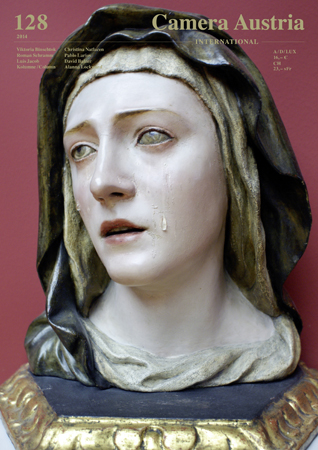Camera Austria International
128 out now
Featuring:
Christina Natlacen on Viktoria Binschtok
David Balzer on Luis Jacob
Pablo Larios on Roman Schramm
Column: Alanna Lockward
Playing through pictorial metaphors and aesthetic and semantic conventions, linking images in an associative-algorithmic manner based on structural characteristics, “poking” into apparent gaps, empty spaces and vulnerabilities in visual narratives—photographic strategies not connected by any clear or comprehensive context—are the main focus of interest in this issue of Camera Austria International.
Viktoria Binschtok initially develops her series using search engines, which compile images according to criteria such as colour components and how they are distributed in the image, contour lines, and the structure of surfaces. In a subsequent process, these images serve as templates for a restaging through which displacements and differences ensue. In her essay, Christina Natlacen compares this conceptual arranging of individual images with “Aby Warburg’s approach to preparing the boards for his ‘Mnemosyne Atlas,’ which still today remains highly influential to artists.” Warburg was also searching for a type of formal analogy—the “pathos formula,” which was supposed to provide him with a hinge for linking images across cultures and over centuries.
Luis Jacob’s work Show Your Wound (2010–12) consists of a sequence of 26 snapshots taken by the artist in museums and galleries across the globe. David Balzer characterises them as an “alliance of contemporary minimalism with historical religious painting and sculpture.” The taken images “are not ironic deconstructions or critiques of museums, as Dadaist readymades were, but rather intent inquires into them, and into the nature of looking.” The museum’s systems of order mainly address visitors solely as viewers: Do not touch. The art-historical works that roll past us disembody the image and visually render the bodies—a mechanism with inherently far-reaching consequences for current pictorial cultures.
Roman Schramm’s photographs, as Pablo Larios writes, progress “through loosely thematic series that operate as formal experiments with formal conceits…” Around his photogenic objects, with the help of a 3D program, he creates one or also multiple spaces that extend beyond the edge of the picture and into the exhibition space. According to the author, these meanwhile absurd, comic constructions refer back to “visual and meaning conventions… the kind of cultural-industrial techniques that are wholly on display in our own era.” Schramm appropriates these conventions to simultaneously modify them and shift them onto themselves.
Camera Austria International
published quarterly, 104–112 pages, German/English
Orders: www.camera-austria.at/shop
